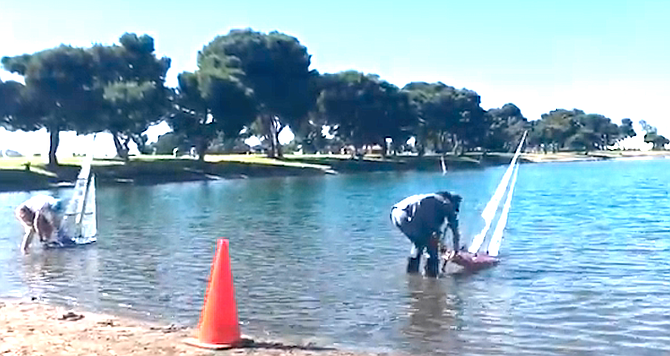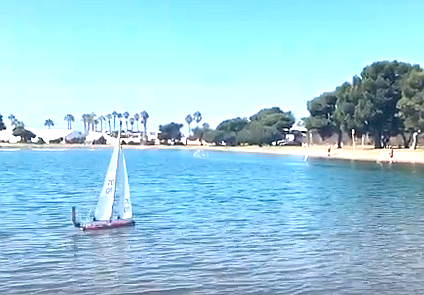 Facebook
Facebook
 X
X
 Instagram
Instagram
 TikTok
TikTok
 Youtube
Youtube

La Jollan Ernie Mortensen has been free sailing 36-inch yachts for 18 years.
On October 20-21, Mortensen was the only San Diegan of eight skippers to compete in the National Freesail Regatta, held at the Model Yacht Pond in Mission Bay. The 900-foot pond is off West Vacation Road and Ingraham Street.
“I happened to be [supposedly] the first guy in San Diego doing this,” Mortensen said, “so I called my boat SD1.”

Two competitors came in from Texas; one from Colorado; one from the Bay Area and another from Orange County. They raced in match style competition where only two boats were raced against one another.
Race director Kim Robbins began each race by staging the skippers by the two orange cones sitting in shallow waters on either the west or east side of the pond. He then yelled “skippers ready” and blew a whistle to prompt each skipper to send their miniatures sailing.
“Then we follow the boats up along the shoreline (west-to-east or east-to-west),” Mortensen said, “if the boat goes into the shore, somebody’s got to turn it around because there’s no remote control.”
Each skipper follows the boat with a turning-pole (PVC wrapped with a soft pad at the end); they had a mate on the opposite side of the pond following in case a wind sent the boat astray into the other side (about 300 feet across).
“The pads are to protect the finish of the boat or the strings holding up the sails,” said Zaine Fisher. She and her father trekked in from Houston, Texas. “Mine just went straight and it’s kinda hard to do that — you just have to set your boat right,” she said.
“If your boat goes to shore you can adjust the vane or you could adjust the sails — but most likely not the sails,” said Mike S. from Santa Cruz. “We had a wind shift right there: it had been southwesterly then it just turned westerly and I had to adjust the angle of the vane to keep it from coming ashore.”
Mike’s boat veered into shore at about midpoint, then he adjusted the vane, the mechanism on the rear of the boat that’s attached to the rudder. The adjustment of the vane helps the skipper steer his/her vessel without adjusting the sails. The vane was used in the hobby/sport prior to the implementation of radio control technology in the 1970s. (The radio style is more popular.)
It took about five minutes and 45 seconds for Mike’s mahogany boat to travel the full 900 feet (eastbound)
“It’s sorta like watching paint dry,” he said. “It’s definitely a relaxing sport.”
Mike lost the “run” which is when the boats travel with the wind; his opponent garnered two points. When the boats travel against the wind it’s called a “beat,” which garners the winner three points.
At the end of the races, the points are tallied up and the highest score wins the race. For this annual regatta, the skippers raced 13 times.
“The trouble is that there’s only two real boat ponds like this in the U.S.,” Fisher said, “there used to be many boat ponds, but then they added fountains in the middle, and you can’t have these races if there’s a fountain.” The other popular free sailing venue is The Spreckels Lake Model Yacht Facility in San Francisco where they have about 25 active free sailers.
Mortensen is seeking other San Diegans that might want to free sail with him. He said there is no fee and in order to compete, the prospective skipper must have access to, build or purchase a boat within the parameters of their 36R class rating rules.
“Your boat is legal in the (36R) restricted class if you stick the haul with the keel and the rudder in a box that measures: 37” x 11” x 9”,” he said. “You can have as much sail on it as you want the boat can look whatever it wants to look like.”
Next year we’ll have six to seven guys come in from the U.K. where free sailing originated, and we’ll have an American team which will be most of these guys and gals present — and it will be an international regatta.”


La Jollan Ernie Mortensen has been free sailing 36-inch yachts for 18 years.
On October 20-21, Mortensen was the only San Diegan of eight skippers to compete in the National Freesail Regatta, held at the Model Yacht Pond in Mission Bay. The 900-foot pond is off West Vacation Road and Ingraham Street.
“I happened to be [supposedly] the first guy in San Diego doing this,” Mortensen said, “so I called my boat SD1.”

Two competitors came in from Texas; one from Colorado; one from the Bay Area and another from Orange County. They raced in match style competition where only two boats were raced against one another.
Race director Kim Robbins began each race by staging the skippers by the two orange cones sitting in shallow waters on either the west or east side of the pond. He then yelled “skippers ready” and blew a whistle to prompt each skipper to send their miniatures sailing.
“Then we follow the boats up along the shoreline (west-to-east or east-to-west),” Mortensen said, “if the boat goes into the shore, somebody’s got to turn it around because there’s no remote control.”
Each skipper follows the boat with a turning-pole (PVC wrapped with a soft pad at the end); they had a mate on the opposite side of the pond following in case a wind sent the boat astray into the other side (about 300 feet across).
“The pads are to protect the finish of the boat or the strings holding up the sails,” said Zaine Fisher. She and her father trekked in from Houston, Texas. “Mine just went straight and it’s kinda hard to do that — you just have to set your boat right,” she said.
“If your boat goes to shore you can adjust the vane or you could adjust the sails — but most likely not the sails,” said Mike S. from Santa Cruz. “We had a wind shift right there: it had been southwesterly then it just turned westerly and I had to adjust the angle of the vane to keep it from coming ashore.”
Mike’s boat veered into shore at about midpoint, then he adjusted the vane, the mechanism on the rear of the boat that’s attached to the rudder. The adjustment of the vane helps the skipper steer his/her vessel without adjusting the sails. The vane was used in the hobby/sport prior to the implementation of radio control technology in the 1970s. (The radio style is more popular.)
It took about five minutes and 45 seconds for Mike’s mahogany boat to travel the full 900 feet (eastbound)
“It’s sorta like watching paint dry,” he said. “It’s definitely a relaxing sport.”
Mike lost the “run” which is when the boats travel with the wind; his opponent garnered two points. When the boats travel against the wind it’s called a “beat,” which garners the winner three points.
At the end of the races, the points are tallied up and the highest score wins the race. For this annual regatta, the skippers raced 13 times.
“The trouble is that there’s only two real boat ponds like this in the U.S.,” Fisher said, “there used to be many boat ponds, but then they added fountains in the middle, and you can’t have these races if there’s a fountain.” The other popular free sailing venue is The Spreckels Lake Model Yacht Facility in San Francisco where they have about 25 active free sailers.
Mortensen is seeking other San Diegans that might want to free sail with him. He said there is no fee and in order to compete, the prospective skipper must have access to, build or purchase a boat within the parameters of their 36R class rating rules.
“Your boat is legal in the (36R) restricted class if you stick the haul with the keel and the rudder in a box that measures: 37” x 11” x 9”,” he said. “You can have as much sail on it as you want the boat can look whatever it wants to look like.”
Next year we’ll have six to seven guys come in from the U.K. where free sailing originated, and we’ll have an American team which will be most of these guys and gals present — and it will be an international regatta.”
Comments